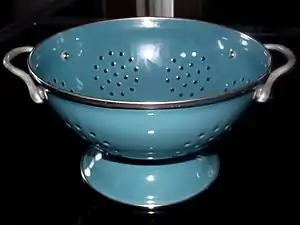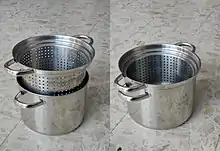
A colander (or cullender) is a kitchen utensil used to strain foods such as pasta or to rinse vegetables.[1] The perforated nature of the colander allows liquid to drain through while retaining the solids inside. It is sometimes also called a pasta strainer or kitchen sieve.
Description and history
Traditionally, colanders are made of a light metal, such as aluminium or thinly rolled stainless steel. Colanders are also made of plastic, silicone, ceramic, and enamelware.[2]
The word colander comes from the Latin colum, meaning sieve.[1]
Types

- Bowl- or cone-shaped – the traditional colander
- Mated colander pot[3]
Other uses

The colander in the form of a pasta strainer was adopted as the religious headgear of the religion Pastafarianism in deference to the Flying Spaghetti Monster.[4]
Colanders are also used during solar eclipses to project multiple images of a partial eclipse onto the ground for safe viewing of the eclipse.[5][6]
See also
References
- 1 2 "colander". merriam-webster.com. Merriam-Webster. 2011. Retrieved 23 May 2022.
- ↑ "Colander". CooksInfo.com. 15 October 2010. Retrieved 30 November 2012.
- ↑ "Mated Colander Pot". justcooking.in. Retrieved 23 May 2022.
- ↑ "Pastafarian protester carries an icon of the Flying Spaghetti Monster at Piazza XXIV Maggio square in Milan, Italy, on June 2, 2012". Wikimedia Commons.
- ↑ "Annular Solar Eclipse Safety". NASA. Retrieved 25 August 2023.
- ↑ "How to observe an eclipse safely". BBC Sky at Night Magazine. BBC. Retrieved 25 August 2023.
External links
 Media related to Colanders at Wikimedia Commons
Media related to Colanders at Wikimedia Commons The dictionary definition of colander at Wiktionary
The dictionary definition of colander at Wiktionary- Colander vs Strainer